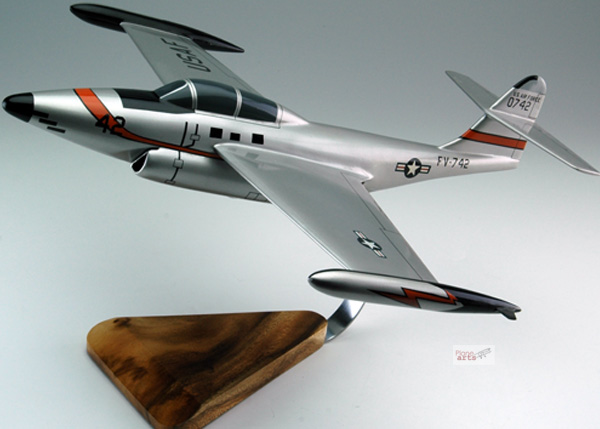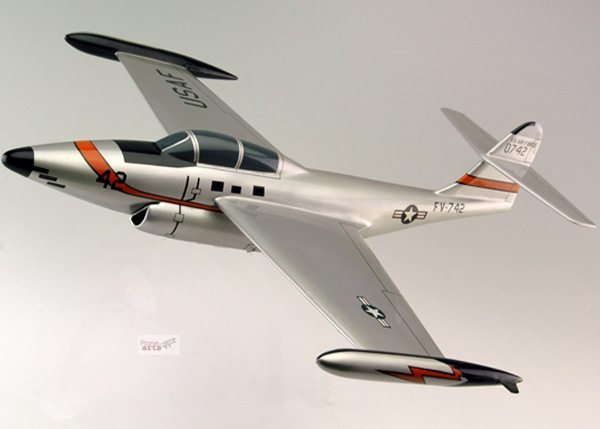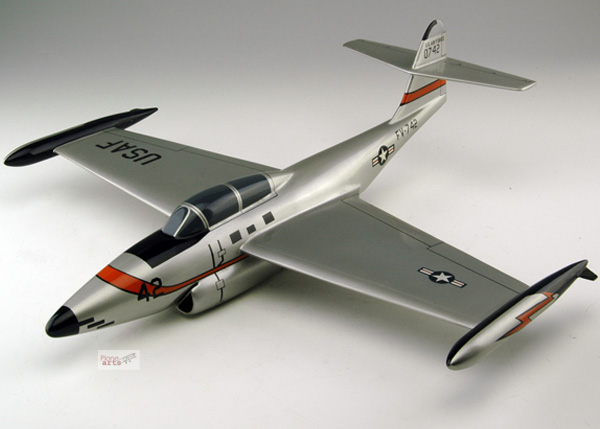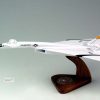Northrop F-89 Scorpion USAF
Production Time 9 to 10 weeks
Shipment is by FedEx, UPS or DHL International Express Courier with a normal door-to-door delivery time worldwide of within 2-3 business days after dispatch. Due to the current volatility of world fuel prices, the amount mentioned here is our best estimate for DHL and UPS and may be subject to change at the time of shipping.

Model Description: Northrop F-89 Scorpion USAF Wood Replica Scale Custom Jet Model
Manufacturer: Northrop
Wingspan: 17.1 Inches (43.4 Centimeters)
Height: 5 Inches (12.7 Centimeters)
Scale: 1:42
$239.50
Production Time 9 to 10 weeks
-
United States dollar ($)
-
Pound sterling (£)
-
Euro (€)
-
Australian dollar ($)
-
Canadian dollar ($)
-
Singapore dollar ($)
-
Swiss franc (CHF)
-
Japanese yen (¥)
-
Danish krone (kr.)
-
Hong Kong dollar ($)
-
Norwegian krone (kr)
-
Swedish krona (kr)
-
United Arab Emirates dirham (د.إ)
General Product Description
Our PlaneArt Northrop F-89 Scorpion USAF model exhibits unique, unrivaled quality and detailed design to come as close as possible to the accuracy of the actual plane. It comes as standard with a robust, durable base or stand which is available in a variety of different finishes designed to match your own personal requirements including solid wood, wood with polished metal supports or adjustable wood wall mount and will be ready within about 9-10 weeks from placement of order.
The Northrop F-89 Scorpion USAF model is made of the finest kiln dried renewable mahogany wood (commonly known as Lauan or Meranti) which has undergone many stages of carving and meticulous and careful sanding giving the beautiful, finished museum quality masterpiece. Many collectors and model connoisseurs demonstrate their preference for genuine handmade and hand painted mahogany wood models rather than plastic or die cast (diecast) alternatives due to the overall look and totally different feel of the item - we trust you will find the same. We can however, if required produce the same model in Solid Cast Resin so just click and contact us for further information. Our craftsmen and gifted artisans ensure that our finely handcrafted model airplanes match the precise blueprint details of the original aircraft. The paint scheme, markings and parts are closely matched, reflecting the original aircraft. This stylish top-quality desktop replica model will surely enthrall anyone who receives this as a gift and for sure one of the most appropriate and desirably collectable gifts for any aviation enthusiast or avid military jet aircraft collector whilst also displaying a perfect resemblance to the actual real life version.
There are many types of military jet aircraft, but the basic types are bombers, fighters, fighter bombers, spotter planes, transporters, patrol aircraft, trainers, and reconnaissance and observation aircraft. All these types of aircraft are used for different types of missions. If you're a fan of historic or present-day military aviation, our model aircraft will bring the excitement and character of these aircraft right into your own home.
If you require, we can also make the Northrop F-89 Scorpion USAF model in any other military, government or even private livery or colour scheme you require and if necessary, in a different size or scale. Just click here to contact us with a description or photographs of what you require, and we will let you have a quotation for the necessary customization by return email. We can also make bespoke scale replicas of any other private / civil commercial airliner or airliners, helicopter, glider, gliders with engines, military propeller, warplane jets, biplane, triplane, tail fin, spacecraft, rocket or NASA model you require in any airline, military or civilian livery or colors. We also produce model airships, blimps, dirigibles, blimps, boats, and ship collectibles. Wall plaque or seal for military, government or private customers. Again, by clicking here to contact us just let us know exactly what you need.
Exploring the Northrop F-89 Scorpion: A Stalwart of Cold War Air Power
In the tense landscape of the Cold War, where the skies were as much a battleground as the ground itself, the Northrop F-89 Scorpion emerged as a sentinel of American air power. Designed to intercept and destroy enemy aircraft, particularly Soviet bombers, the F-89 played a crucial role in defending the skies over North America during a period of heightened geopolitical tensions. Let’s delve into the history, design, and legacy of this remarkable aircraft.
Origins and Development:
The genesis of the F-89 traces back to the late 1940s when the United States Air Force (USAF) sought a dedicated interceptor to counter the evolving threat of long-range bombers. Northrop Corporation, under the leadership of aviation pioneer Jack Northrop, answered this call by developing the F-89 Scorpion. First flying in 1948, the F-89 showcased advanced features for its time, including a radar-equipped nose cone, swept wings, and a unique twin-engine configuration.
Design Features:
The F-89 was a formidable aircraft designed for one primary purpose: interception. Its sleek, all-metal airframe housed a powerful radar system in the nose cone, allowing it to detect and track incoming enemy aircraft at considerable ranges. Armed with a battery of rockets and/or air-to-air missiles, the F-89 could engage multiple targets simultaneously, a capability crucial for defending against massed bomber formations.
One of the most distinctive features of the F-89 was its twin-engine setup, with two Allison J35 turbojet engines mounted side by side in the fuselage. This configuration not only provided redundancy in case of engine failure but also enhanced the aircraft’s overall performance, particularly in terms of speed and climb rate.
Operational History:
Entering service in 1950, the F-89 quickly became the backbone of America’s air defense network. Operating from bases across the continental United States and Canada, F-89 squadrons stood vigilant, ready to intercept any incursions into North American airspace. During this period, the F-89 underwent several upgrades and variants, including reconnaissance versions equipped with cameras for aerial surveillance.
One of the most notable episodes in the F-89’s operational history occurred during the Cold War’s height in the late 1950s. In 1957, an F-89C Scorpion famously fired a live nuclear-tipped Genie air-to-air missile as part of Operation Plumbbob, a series of nuclear tests conducted by the United States. While thankfully never used in combat, this demonstration underscored the F-89’s role as a deterrent force in the nuclear age.
Legacy:
Although eventually replaced by more advanced interceptors like the F-102 Delta Dagger and F-106 Delta Dart, the F-89 Scorpion left an indelible mark on the annals of military aviation. Its service during the tense years of the Cold War helped safeguard American skies and deter potential adversaries. Additionally, the F-89’s versatile design paved the way for future generations of interceptor aircraft, influencing the development of air defense systems for decades to come.
Conclusion:
The Northrop F-89 Scorpion stands as a testament to innovation and ingenuity in the realm of military aviation. From its inception during the early Cold War era to its eventual retirement, the F-89 played a crucial role in defending the United States and its allies against airborne threats. Its sleek silhouette and formidable armament symbolize an era defined by the constant vigilance of air power in the face of geopolitical tensions. Though consigned to the pages of history, the legacy of the F-89 Scorpion endures as a reminder of the courage and dedication of those who served in its cockpit.
| Weight | 6 kg |
|---|---|
| Dimensions | 15.4 × 17.1 × 5 in |











Reviews
There are no reviews yet.